
Parade of Spirits: Spectacular Float Festivals in Hyōgo, Ehime, and Tochigi
Guideto Japan
Culture- English
- 日本語
- 简体字
- 繁體字
- Français
- Español
- العربية
- Русский
The Spirits Come to Town
On festival days, parishioners convey kami through neighborhoods in portable shrines called mikoshi. Humans join the deities aboard dashi, floats that accompany the processions, with festival music and performances by mechanical dolls, local Kabuki actors, and traditional nihonbuyō dancers put on for the spirits adding to the lively scene.
While mikoshi generally resemble Shintō shrine buildings, dashi come in all shapes and sizes. The floats are often two-storied vehicles with gabled roofs and wooden wheels. They go by such names as yatai, yama, hikiyama, and danjiri depending on the region.
Dashi are thought to have their origins in the Daijōsai, a Shintō ritual of thanksgiving conducted on important occasions, such as when an emperor is enthroned. The rite has a close counterpart in the Niinamesai in which newly harvested rice is offered to the deities, a ceremony performed yearly on November 23. In times past, a mound of sacred sakaki tree branches, the hyōnoyama, was constructed as part of the Daijōsai to guide the spirits descending from the heavens.
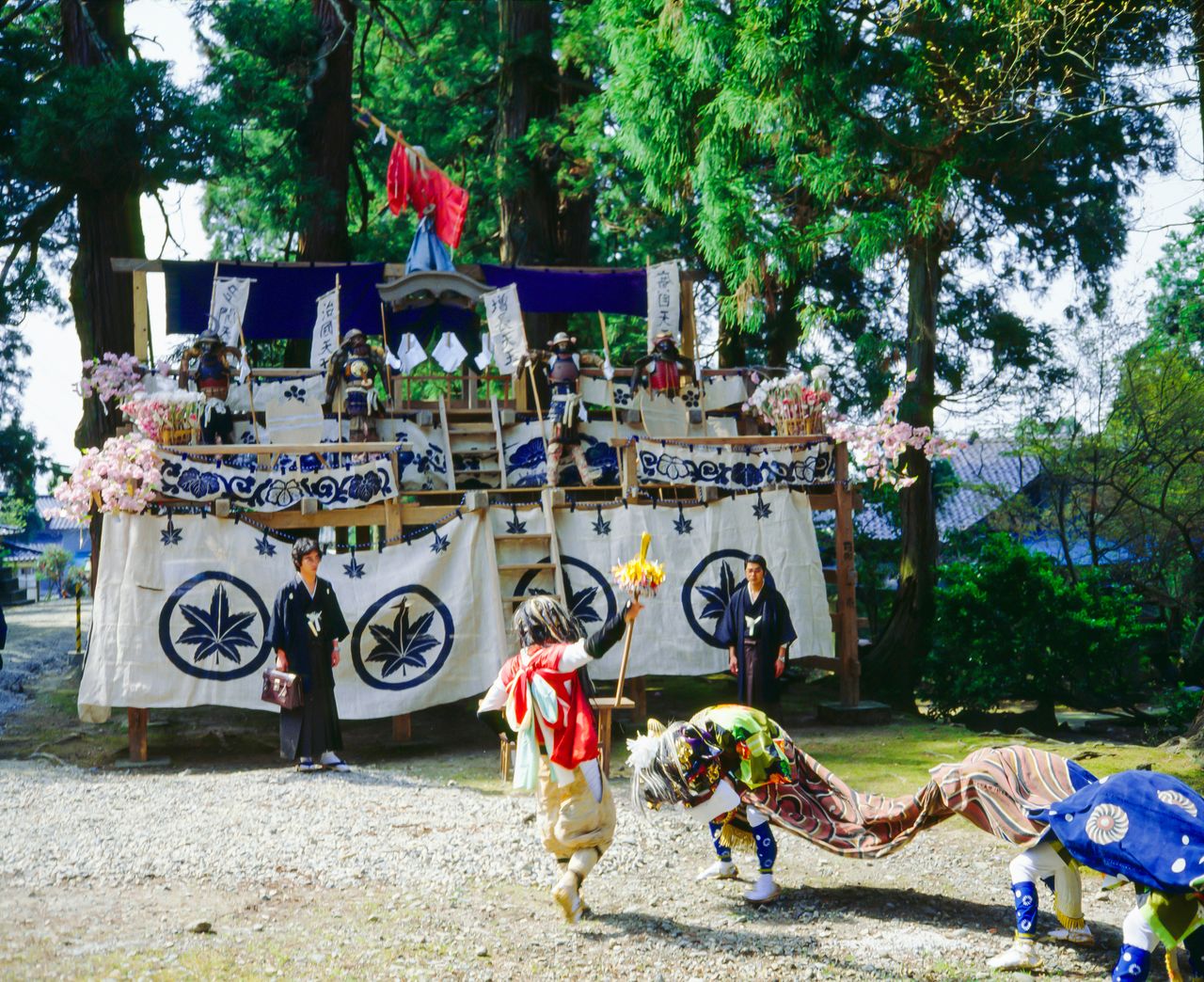
At Futagami Imizu Shrine in Takaoka, Toyama Prefecture, the tsukiyama ritual of building a sacred mound takes place on April 23 every year. Even today, a portable mound serving as a shrine is erected, a relic of ancient religious beliefs. (© Haga Library)
Similar mounds were erected for ordinary festivals, and gradually these evolved into the various floats that are used today. One of the most famous celebrations showcasing dashi, Kyoto’s Gion Festival, started as a procession of halberds, but now features 34 ornately decorated floats that trace their lineage to a sakaki mound built for a Daijōsai held in 999.

The Mitsuyama festival of Itatehyōzu Shrine in Himeji, Hyōgo Prefecture, takes places once every 20 years. Three towering wood structures representing mountains are decorated with colorful cloth to welcome spirits from across the land. This ritual has been carried out since 939, predating the development of floats. (© Haga Library)
Japan has a great variety of distinct dashi festivals that have developed in rural communities. Below I present three that feature especially unique and spectacular floats.
Nada no Kenka Festival
(October 14–15, Himeji, Hyōgo Prefecture)
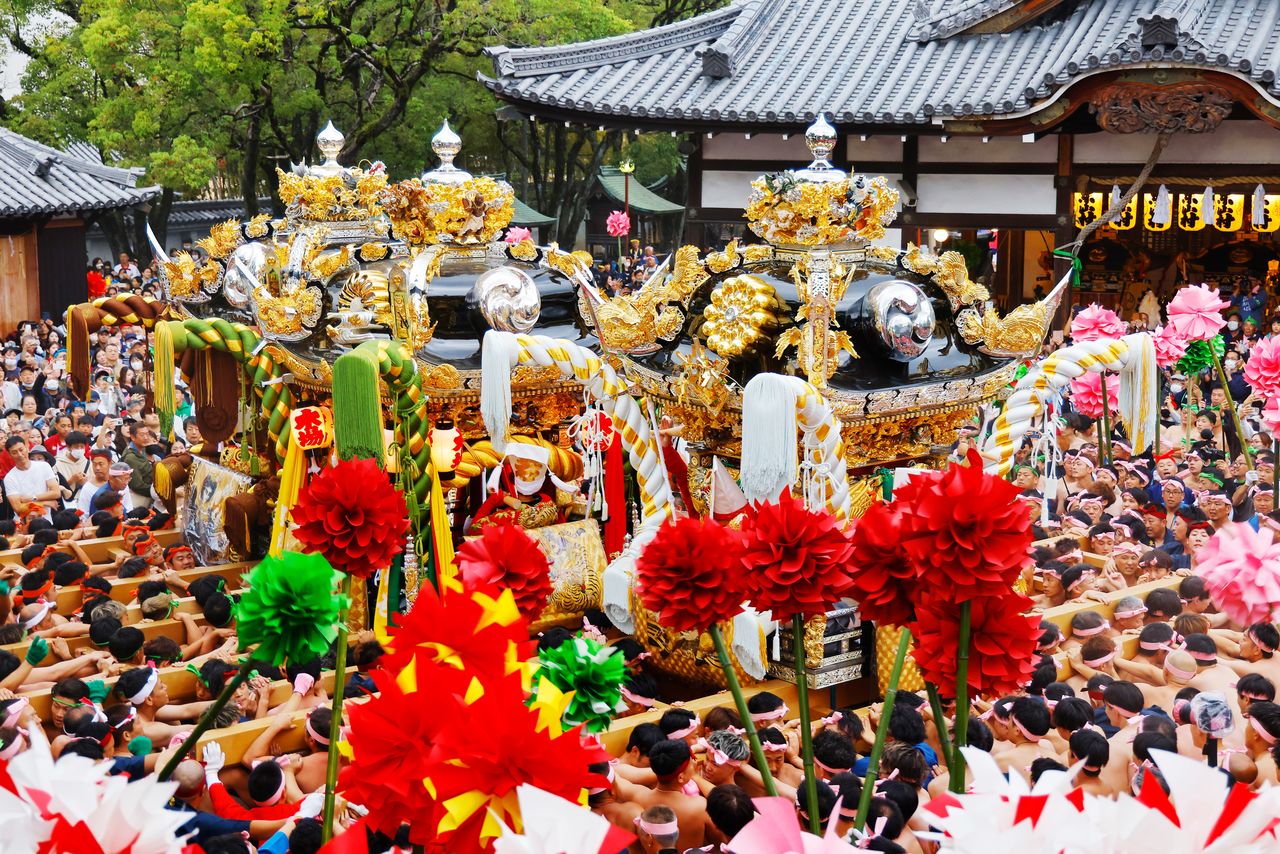
Three colorfully decorated mikoshi are paraded in front of the shrine. Parishioners from seven districts participate, each sporting headbands in the color representing their neighborhood. (© Haga Library)
The Harima region of southwest Hyōgo Prefecture is famous for its Banshū autumn festivals featuring processions of floats with large, lacquered roofs. In particular, the seven floats from communities in the Nada district of Himeji boast roofs beautifully decorated with gold accents. These appear in the Nada Fighting Festival. Formally the annual autumn festival of Matsubara Hachiman Shrine, the event arose as a celebration by parishioners after local lord Akamatsu Masanori rebuilt the shrine, which had burned down during wars in the fifteenth century.
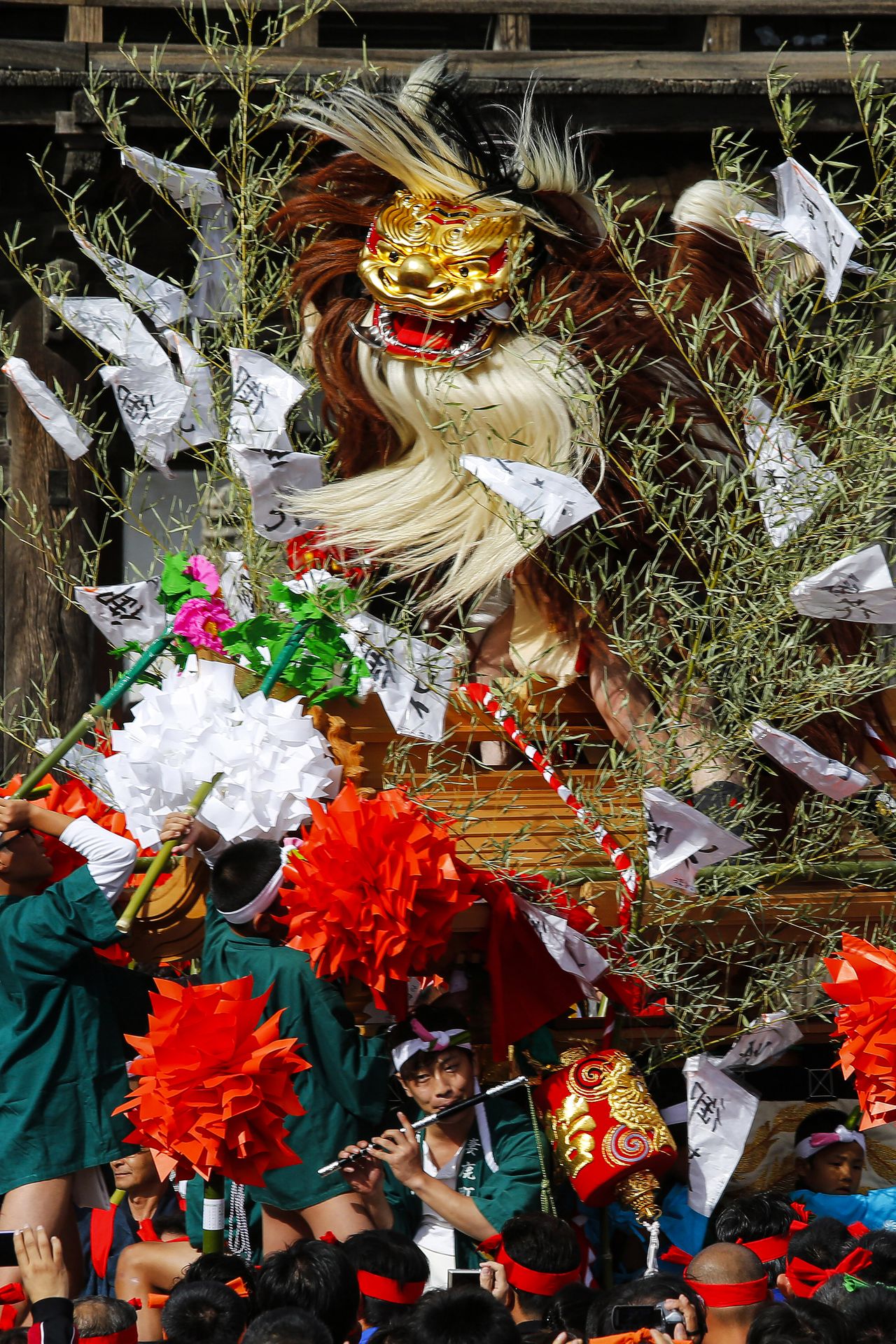
With huge banners leading the procession, a performance of the shishimai lion dance and a lion float clear the path for the main float entering the shrine. (© Haga Library)
On the first day of the festival, the floats from the seven districts are assembled for worship at the shrine. The structures, which have no wheels and weigh two and a half tons, are carried aloft by teams of 200 to 300 parishioners each. The groups taunt each other, and at a signal of lifting their floats up and down, they line up and rush in a human wave, smashing against each other. Any loss of balance causes the huge floats to tip, a stirring sight for spectators.
The main festival takes place on the second day, when the floats are paraded in front of thousands of spectators on their way to the foothills of Otabiyama nearly two kilometers west of the shrine.
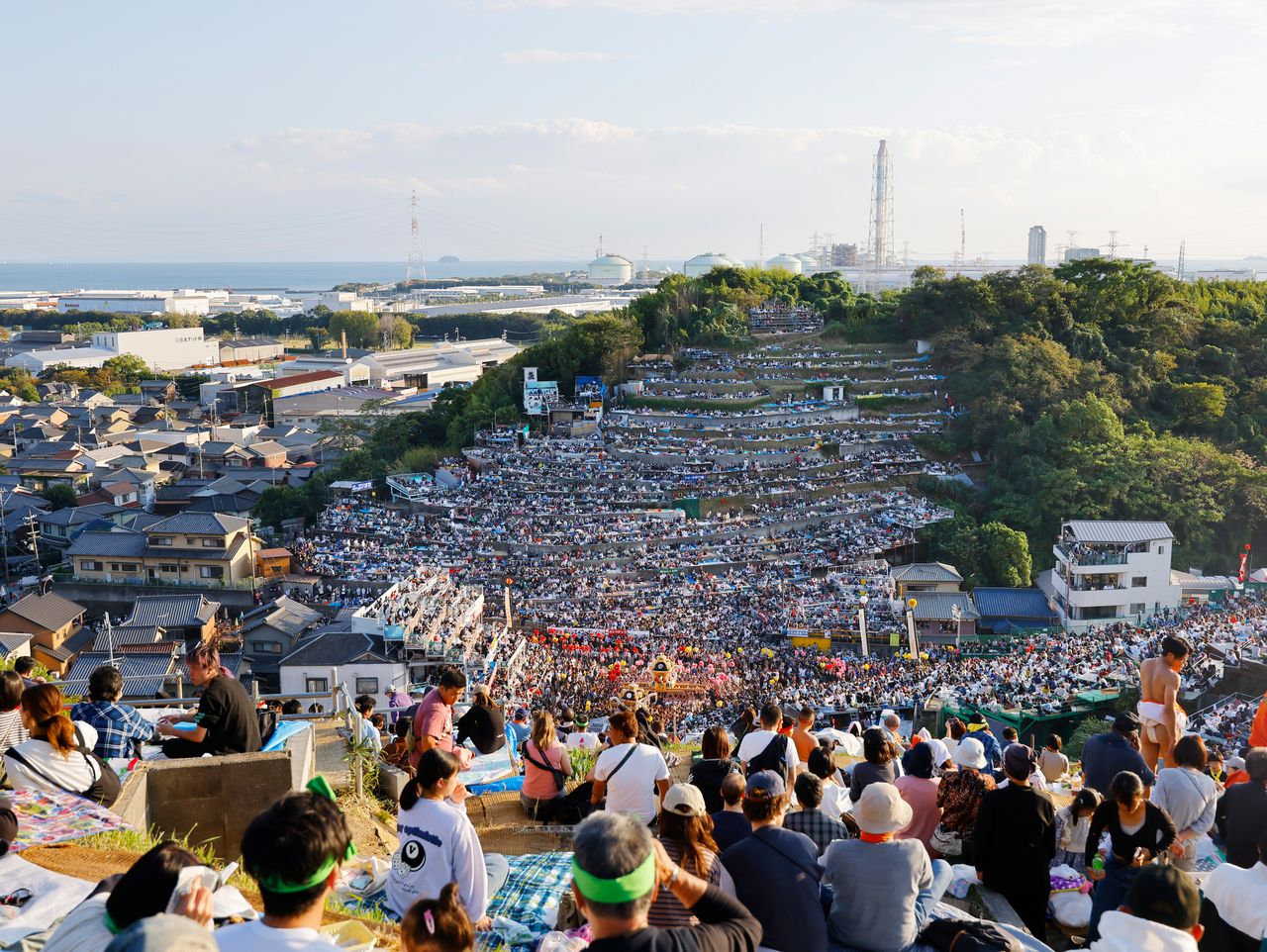
A bird’s eye view from the summit of Otabiyama, looking out toward the Harima Sea in the distance. The best views are from stands reserved for local residents and invited guests, but the festival still offers plenty of excitement for the crowds watching from above. (© Haga Library)
New floats are constructed every few decades. In 2014, two districts unveiled new floats, with each holding its own in the shoving contest, creating a thrilling spectacle.
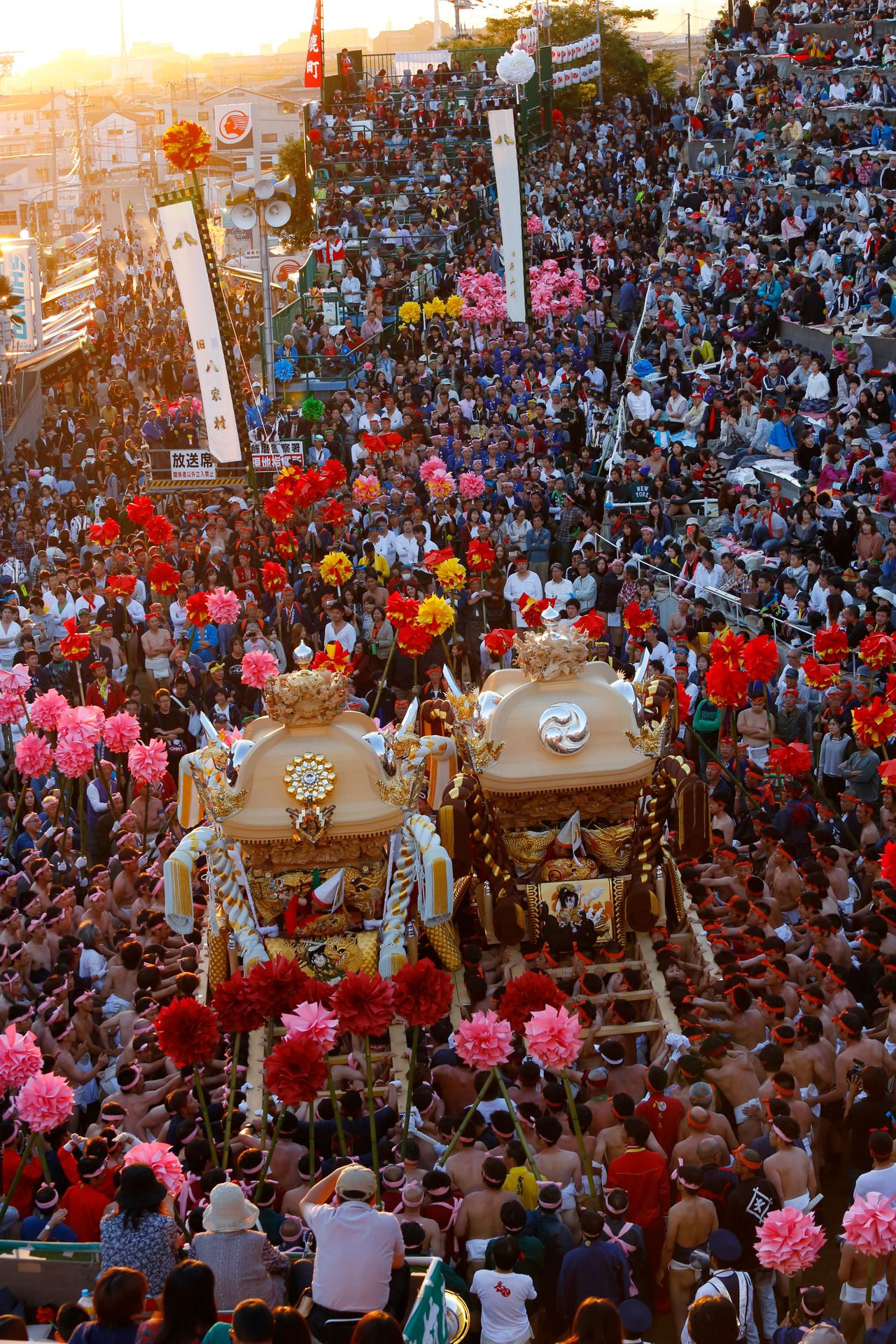
Newly constructed floats are not lacquered for the first two years, their unadorned surfaces giving them a venerable air. (© Haga Library)
Another highlight is the sight of three mikoshi clashing. Although the event is billed as a “fighting festival,” the action actually represents a fleet of ships led by Jingū, a legendary empress enshrined at Matsubara Hachiman Shrine, rubbing against each other to remove oyster shells from their hulls.
The mikoshi bearers are from one of seven districts, with each taking turns leading the festival. Believing that the more damage the mikoshi suffers, the more pleased the deities will be, each district is eager to outdo the others in the vigor of its efforts. The pushing and shoving continue through the afternoon until night. If a mikoshi ends up with a hole in its roof, all the better. The damaged structures are left at the shrine’s worship hall and turned over to the district whose turn it will be to lead the following year’s festival.
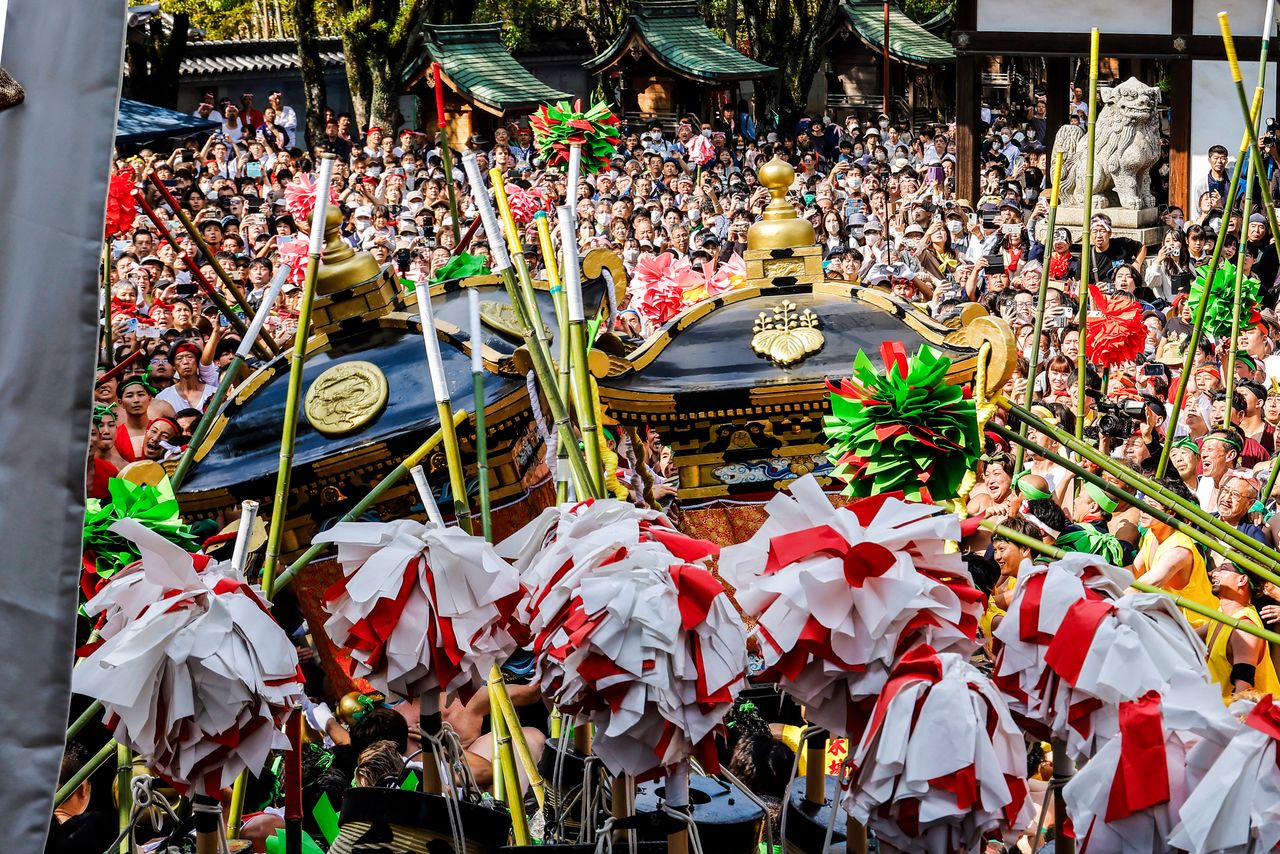
Smaller mikoshi are hoisted aloft with the help of bamboo poles. The teams vie to push their mikoshi higher than their neighbors’. (© Haga Library)
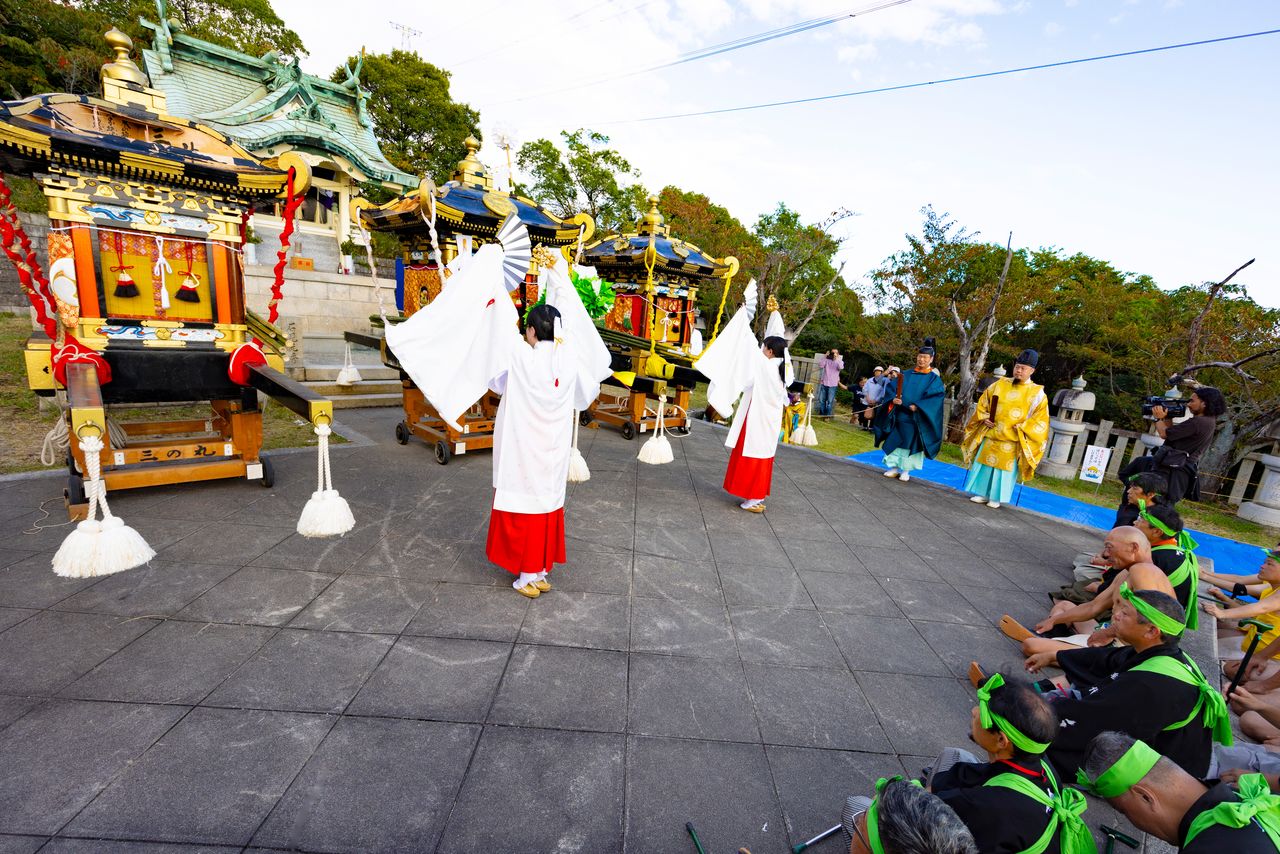
The mikoshi, fresh from battle, return to their abode on Otabiyama. Shrine maidens offer a dance to the spirits. (© Haga Library)
Niihama Taiko Festival
(October 15–18, Niihama, Ehime Prefecture)
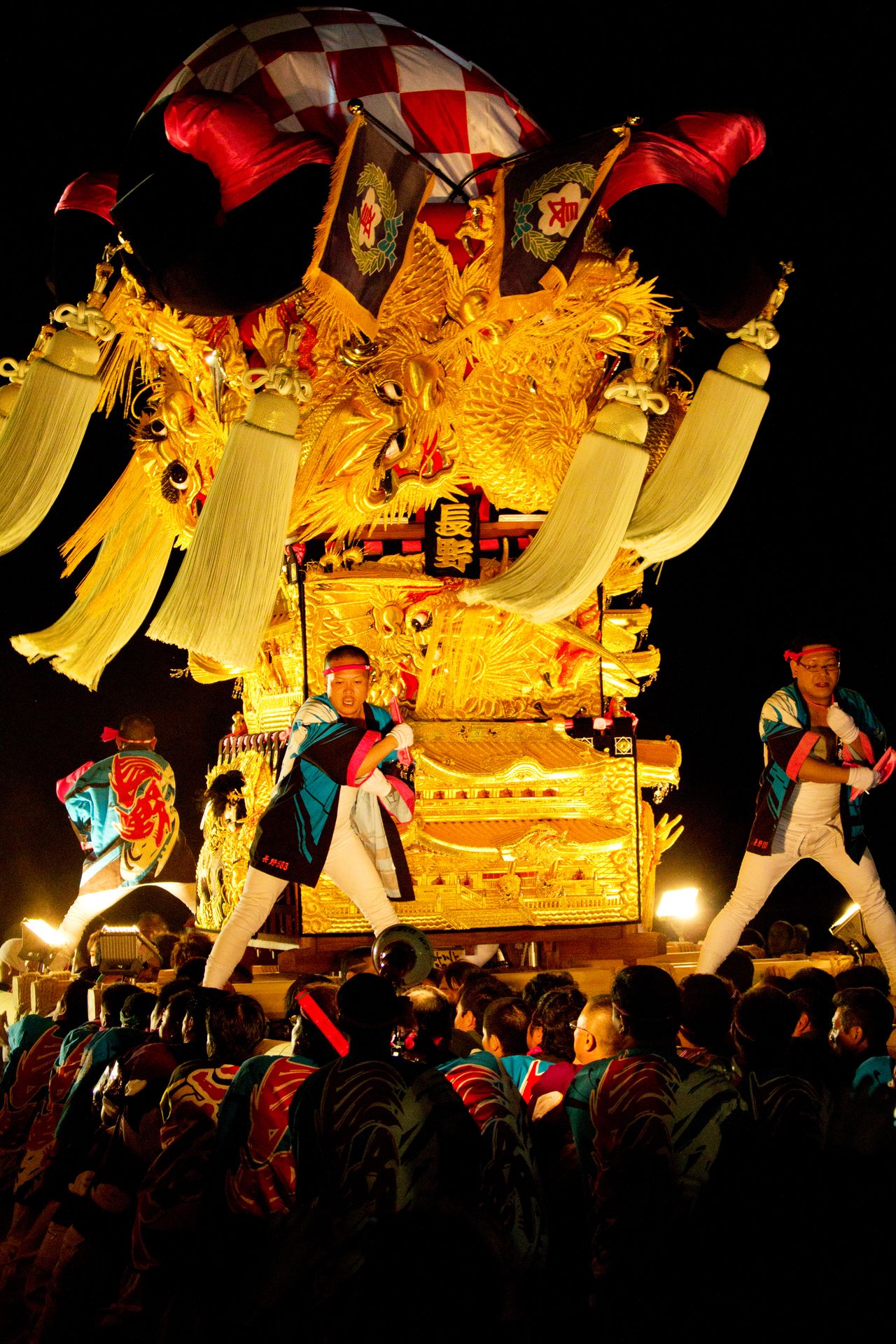
The floats’ gorgeous gold embroidery is evidence of the town’s past prosperity. (© Haga Library)
The saying goes that while Niihama natives may not make customary visits to their hometown for New Year’s and Obon, they will always return for the Taiko Matsuri. This is proof of the festival’s popularity in Niihama, a town in the eastern part of Ehime Prefecture where fishing is the primary occupation. The highlight of the lively festival is a huge drum, pounded energetically by young men, that sets perched atop a platform standing five and a half meters tall and weighing three tons that requires 150 men to carry.
More than 50 drum floats participate in the festival, each decorated with exquisitely embroidered curtains, huge tassels, and a cushioned platform for the drums. Its most distinctive feature is the three-dimensional embroidery depicting scowling dragons on the decorative curtains. The curtains are created by skilled embroiderers using real gold thread, with each costing as much as ¥10 million.
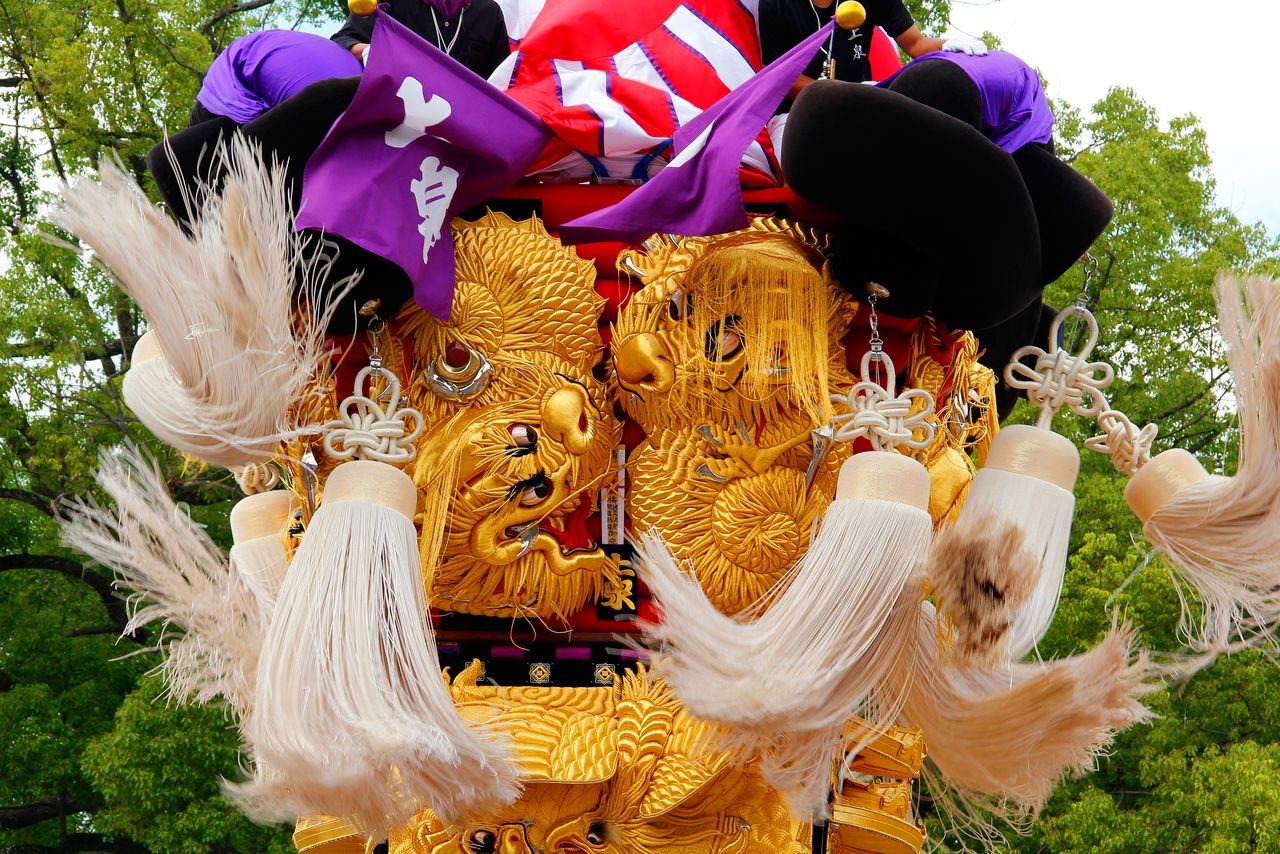
The more vigorously the drum floats are shaken and the tassels jostled, the more visible the dragons, showing off the embroiderers’ skills. (© Haga Library)
The drum floats first appeared as part of an existing autumn festival around the first half of the nineteenth century. Initially small affairs, they grew larger and more elaborate as districts began to vie with one another toward the end of the nineteenth century when the town prospered thanks to the Besshi copper mine on which the riches of the prewar Sumitomo financial combine were built.
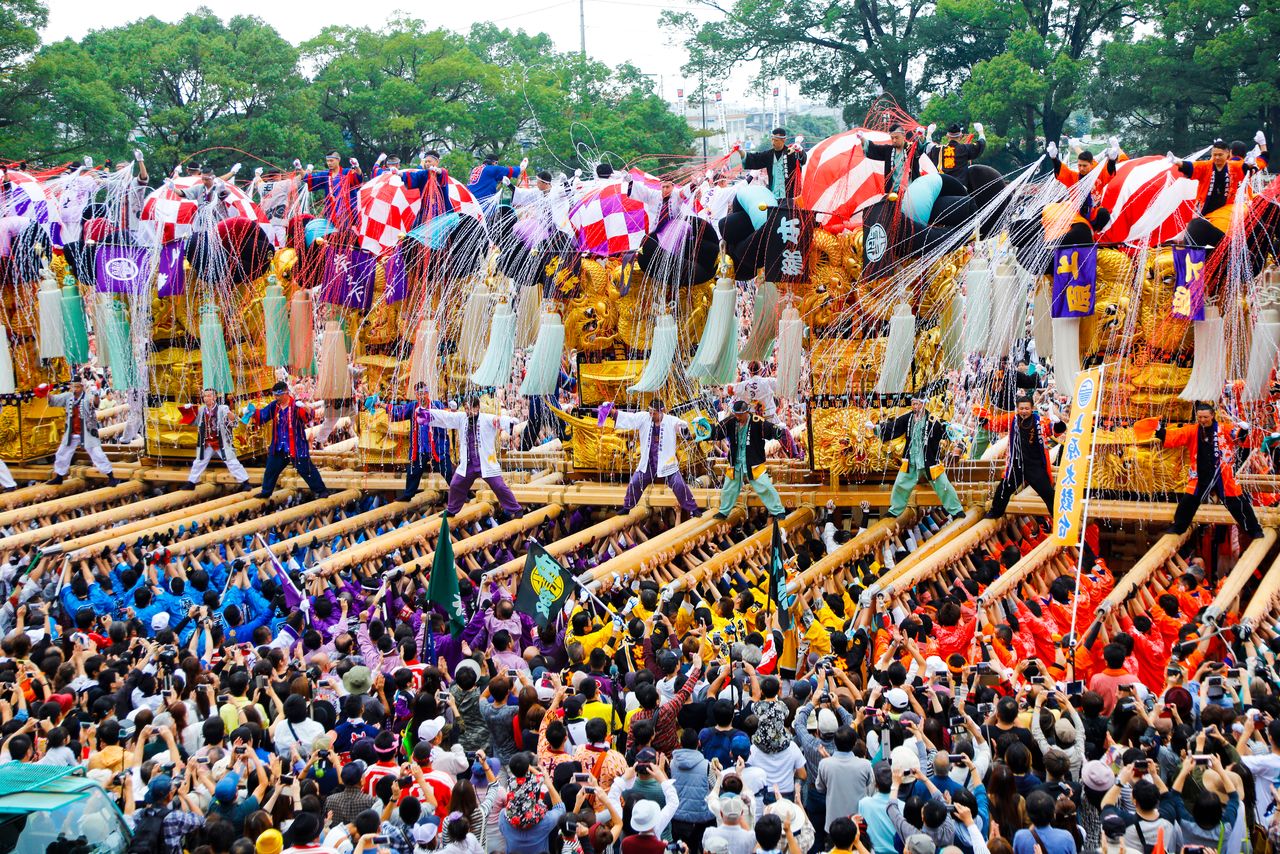
Dozens of drum floats line up in a colorful spectacle. (© Haga Library)
The festival highlight is on October 17 when the 20 or so drum floats are lined up at the festival site and maneuvered in a perfectly coordinated display. The floats appear before spectators one by one, each heaving violently up and down. Next, several are lined up very close to each other and slowly turned in unison. The hundreds of float bearers moving in sync are an impressive sight conveying the town’s spirit of solidarity and mutual assistance.
At dusk, the floats are moved to a different venue, where the performance is repeated. The atmosphere is electric with anticipation when the floats move into fight mode. Young men open a path through the crowds to make way for the floats, and whistles and voices rise to a crescendo as the floats clash with a thundering sound. The intensity of it all is a spectacular, soul-stirring sight that showcases the essence of the festival.

In the past, the decorative hangings were removed to allow for more intense clashes. (© Haga Library)
Kanuma no Aki Festival
(Second Saturday and Sunday of October, Kanuma, Tochigi Prefecture)
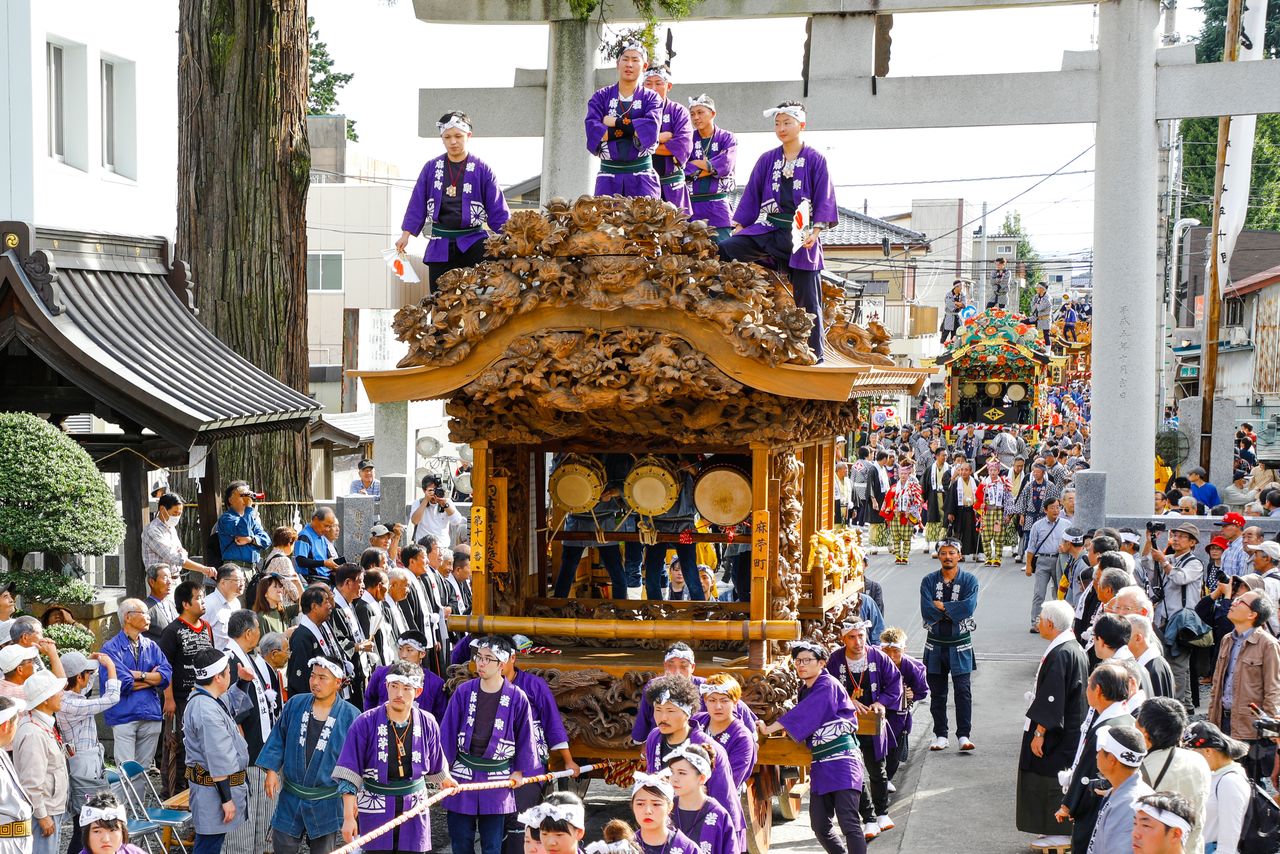
The float from the Asau district features especially intricate carvings. The golden dragon decorating the transom is the work of a master carver Hidari Jingorō XII. (© Haga Library)
Tochigi Prefecture’s Nikkō Tōshōgū, erected in the early 1600s, is known for its resplendent wood carvings. The shrine complex is fronted by the Yōmeimon Gate, decorated with 508 carvings, and the worship hall is famous for its carving of a sleeping cat and the “see no evil, hear no evil, speak no evil” trio of monkeys. Kanuma, which lies 25 kilometers southeast of the shrine, was a post town on the highway between Edo (today Tokyo) and Nikkō, where woodworking is a thriving craft thanks to the skills passed down by the shrine carpenters who erected Tōshōgū. Kanuma’s festival floats are famed for their ornate carvings, created by famous sculptors like Hidari Jingorō XII.
Kanuma Imamiya Shrine’s autumn festival boasts 27 floats, all gorgeously carved and appearing like miniature Tōshōgū on wheels. The festival was first held in 1608 to celebrate answered prayers for rain after a severe drought and featured sacred dances performed on floats as offerings of thanks.
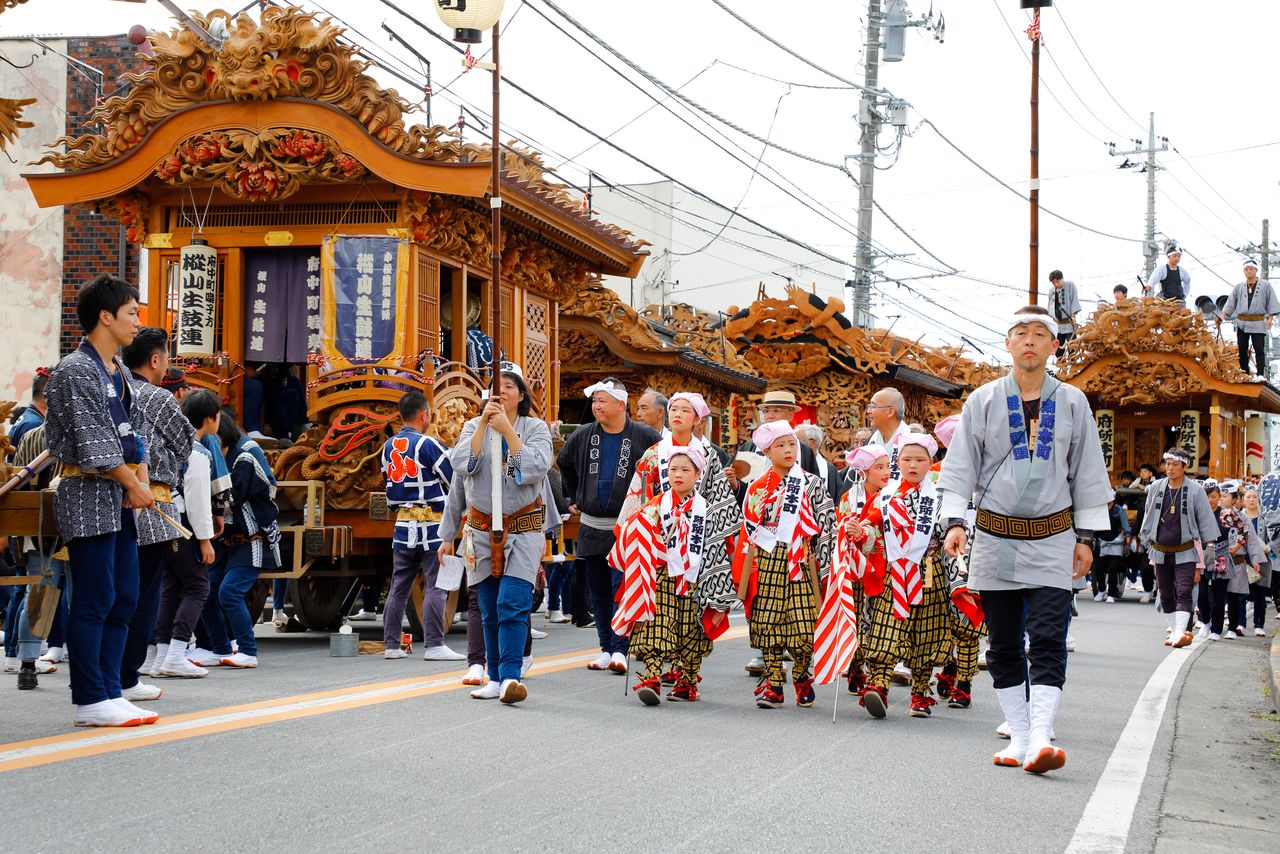
Residents of each district parade in distinctive festival outfits reminiscent of the Edo period. (© Haga Library)
On the opening day of the festival, floats from the town’s 27 districts form a procession to Imamiya Shrine. Leading the way are tekomai dancers, young girls dressed in traditional juban robes worn over one shoulder and overskirts and bearing iron clubs and wooden clappers. Men astride the floats’ roofs strike imposing stances. Once worship at the shrine has concluded, the floats are decked out in lanterns at nightfall and paraded to the center of town.
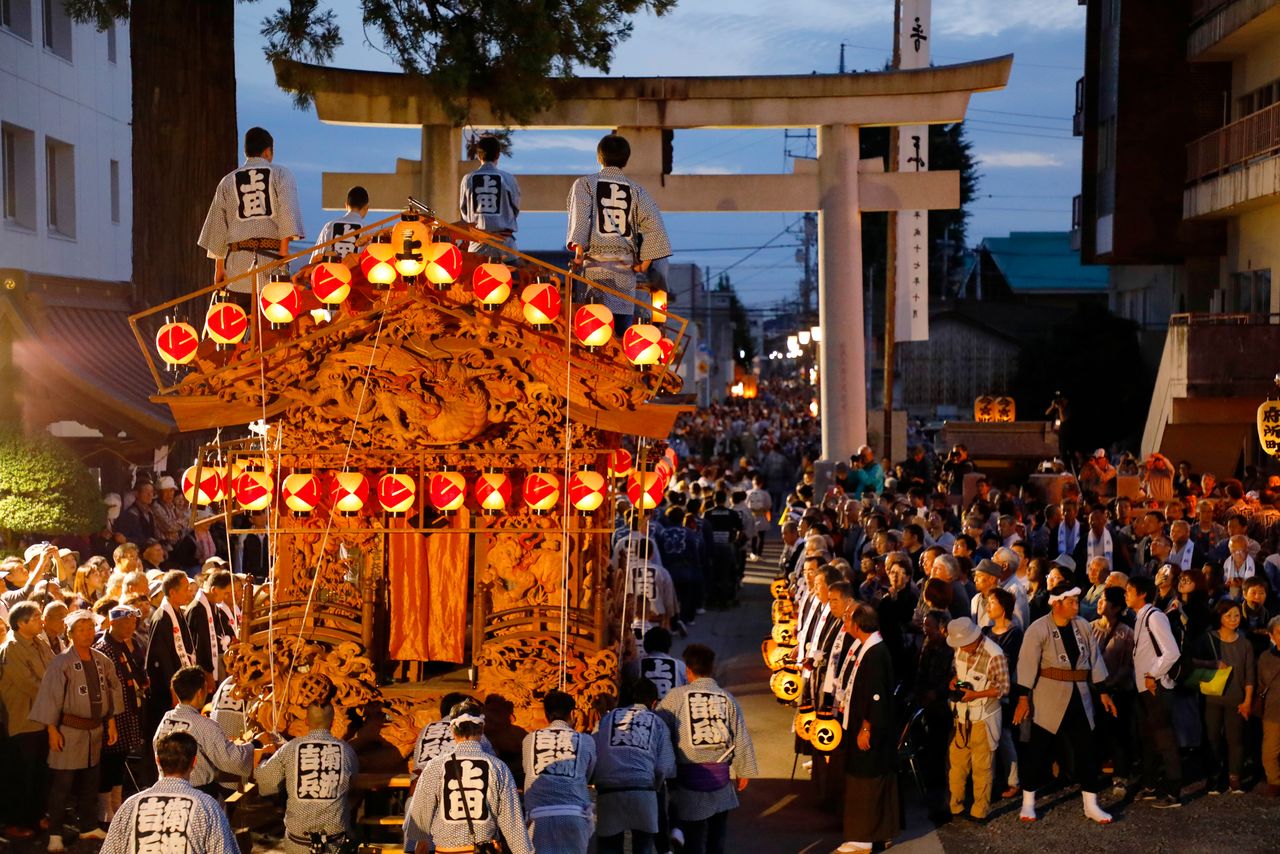
Festival music begins once the lanterns are lit. (© Haga Library)
Over the two days of the festival, numerous floats are carried to major intersections in town to engage in contests between musicians on the floats. Once called the Kanuma Butsuke (bumping) Festival, the name refers to the frenzied playing of the festival music. Amid the cacophony, the musicians close their eyes and concentrate on their playing. The charm of the festival comes from the diverse sounds washing over the crowded space like a wave and generating a feeling akin to floating in outer space.
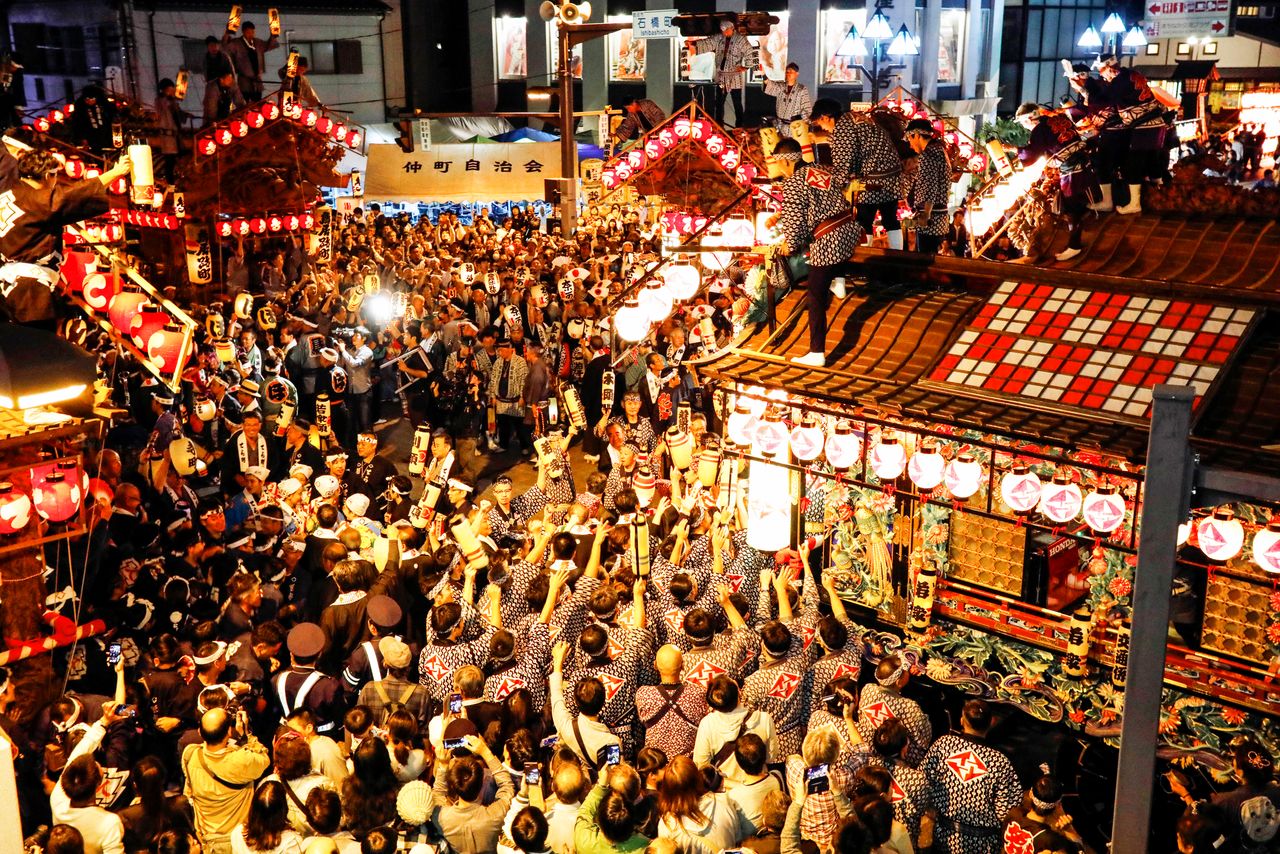
Crowds chant excitedly to the accompaniment of lively festival music. (© Haga Library)
(Originally published in Japanese. Dates given are those on which the festivals are usually held. Banner photo: Mikoshi at the Nada Fighting Festival. © Haga Library.)
